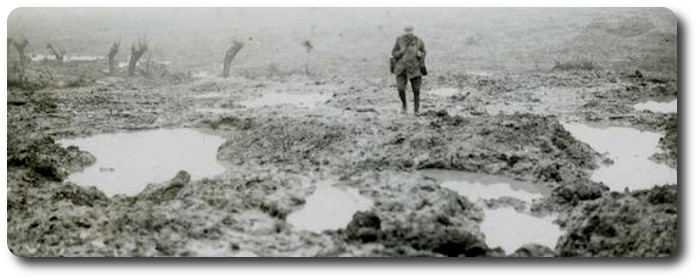Topic: The Field of Battle

Winter on the Somme
The Roses of No Man's Land, Lyn MacDonald, 1980
In that winter's [1916-17] lull in the fighting along the vast frozen length of the line, the elements were the real enemy. It was worst of all on the Somme. After the Germans retired to the Hindenburg Line they left behind a frozen tundra—pock-marked with shellholes, scarred by a network of now-useless trenches, and devoid of any shelter but the concrete chill of old dugouts, which were swiftly occupied by squeaking packs of the outsize, blood-bloated rats that preyed on the corpses of long-dead soldiers. The few dreary encampments that marked the staging posts of the long haul through the wilderness to the new front line offered little in the way of comfort to the half-frozen infantry who trudged up to man it.
Although there was little fighting in the winter wastes, and little was expected before the spring, it was not possible to withdraw large numbers of men to the comparative comfort of billets in the rear and to garrison the line with a skeleton force. Forty-eight hours were as much as a battalion could be expected to remain in the open trenches, and large numbers of troops had to be frequently rotated if the fighting force was not to succumb en masse to exposure, pneumonia or trench-feet. As it was, the large numbers of men sent down the line suffering from trench-feet caused the army such anxiety that special orders were issued. Every man must carry a spare pair of dry socks at all times. At least once a day every man must remove boots and stockings and rub his feet with whale-oil, and every platoon officer was to be held responsible for seeing that this was done.
But it was not easy to persuade a shivering soldier to divest his icy feet of what little protection they had. When the trenches were merely frozen hard the problem w as less acute. When the sun came out or when the thermometer rose a degree or two above zero and the icy ground began to thaw, the soldiers sank up to their knees into a layer of icy slush. In such conditions it was physically impossible to carry out the whale-oil-rubbing, foot-inspection drill. Frozen and wet, stiff and numb, with no means of exercising to restore the circulation already impeded by tightly-bound wet puttees, the feet of the unfortunate infantrymen turned into one vast and excruciating chilblain. In the worst cases, men were literally unable to walk. In the face of mounting casualties, GHQ grumbled and roared, threatened and sent demands for explanations to corps, to brigades, to battalions and to companies in the line, warning dire consequences if the situation did not improve.
The exasperated CO of the 16th Battalion, the Highland Light Infantry, driven to distraction by the continuous badgering, eventually wrote to Brigade, 'I have given you every explanation that is humanly possible. If you are not satisfied, I must refer you to God Almighty.' He heard no more.

